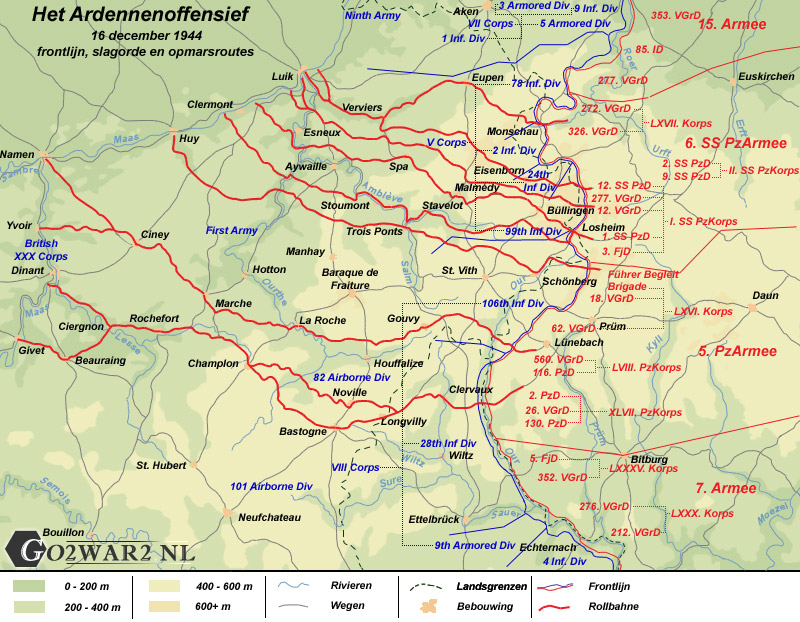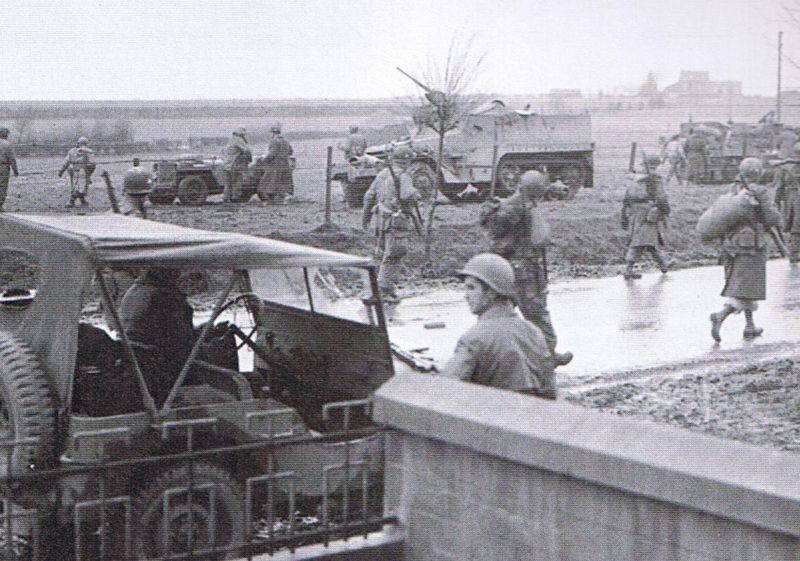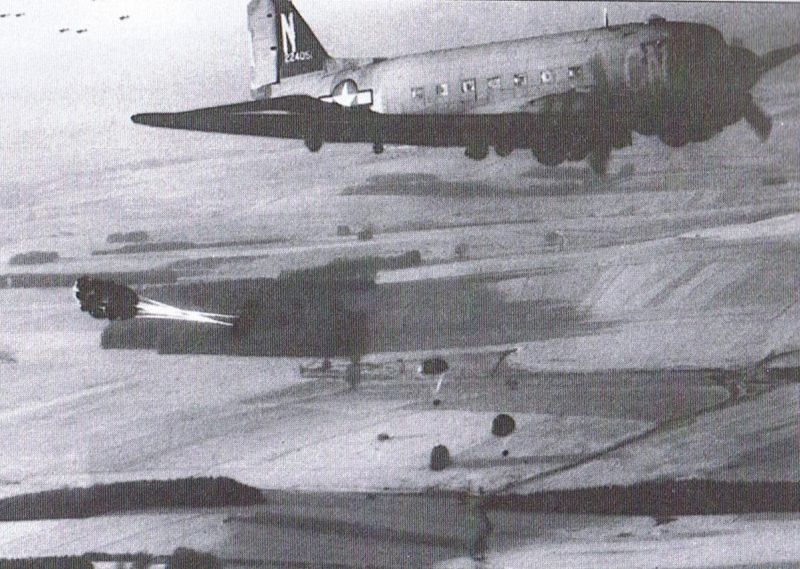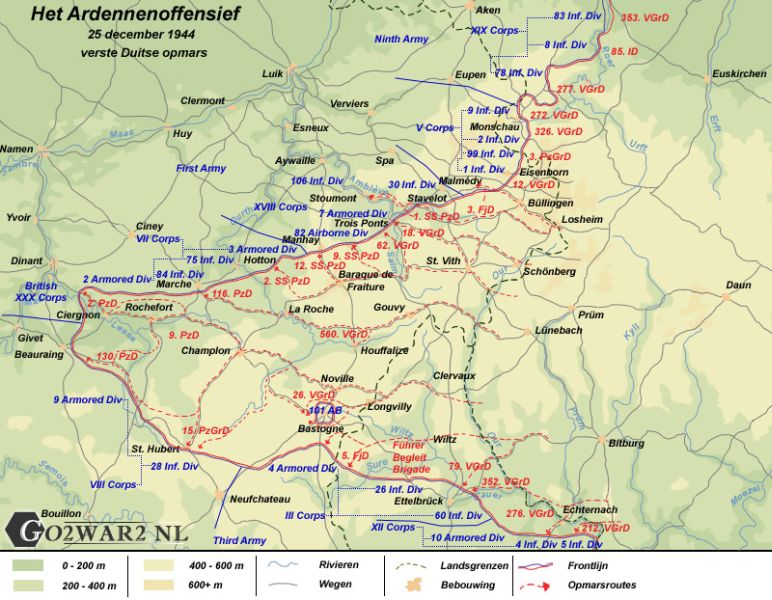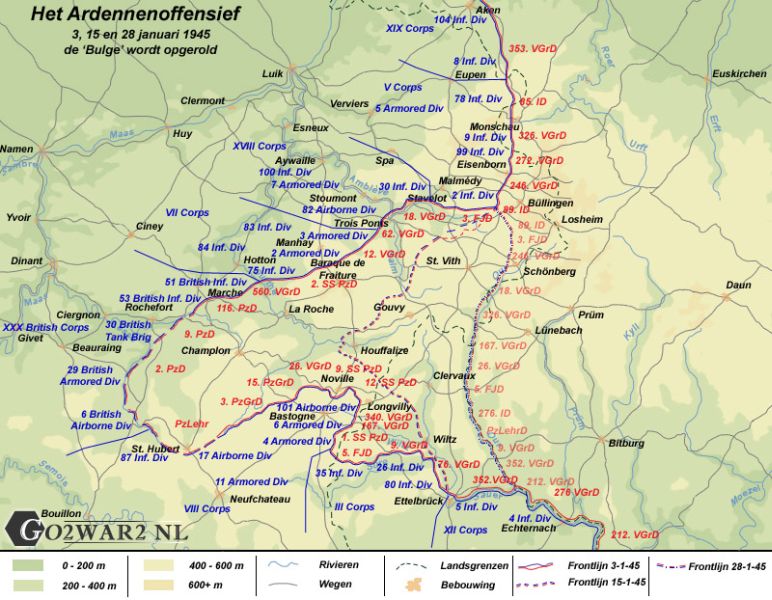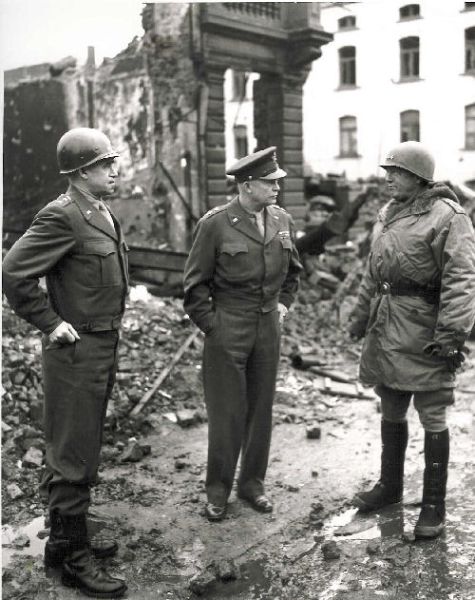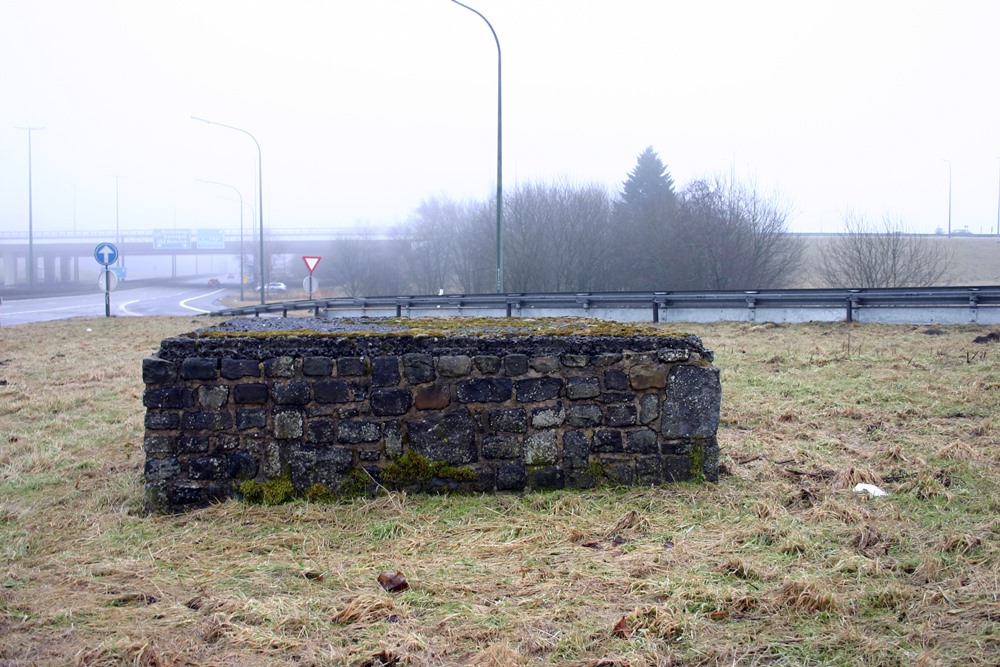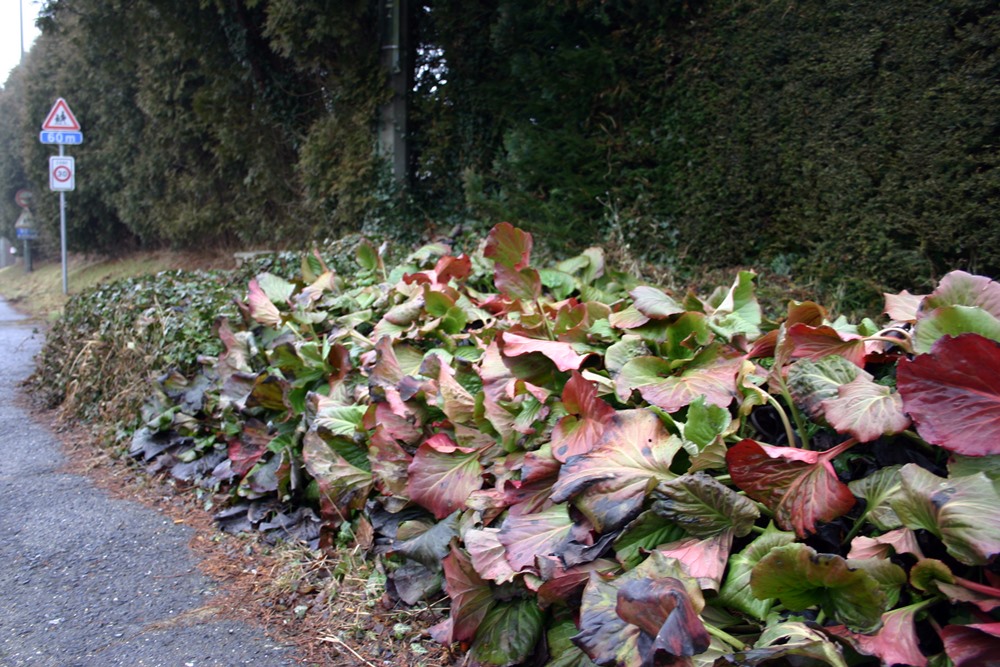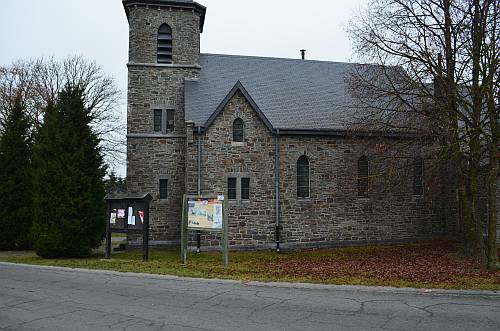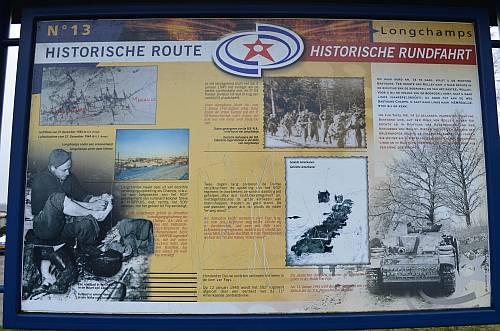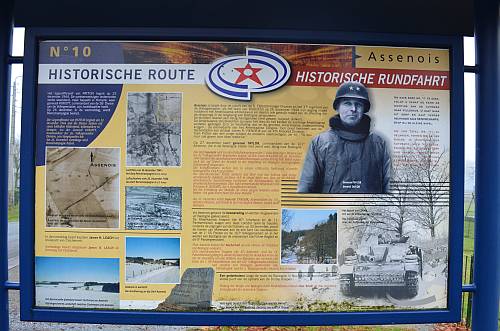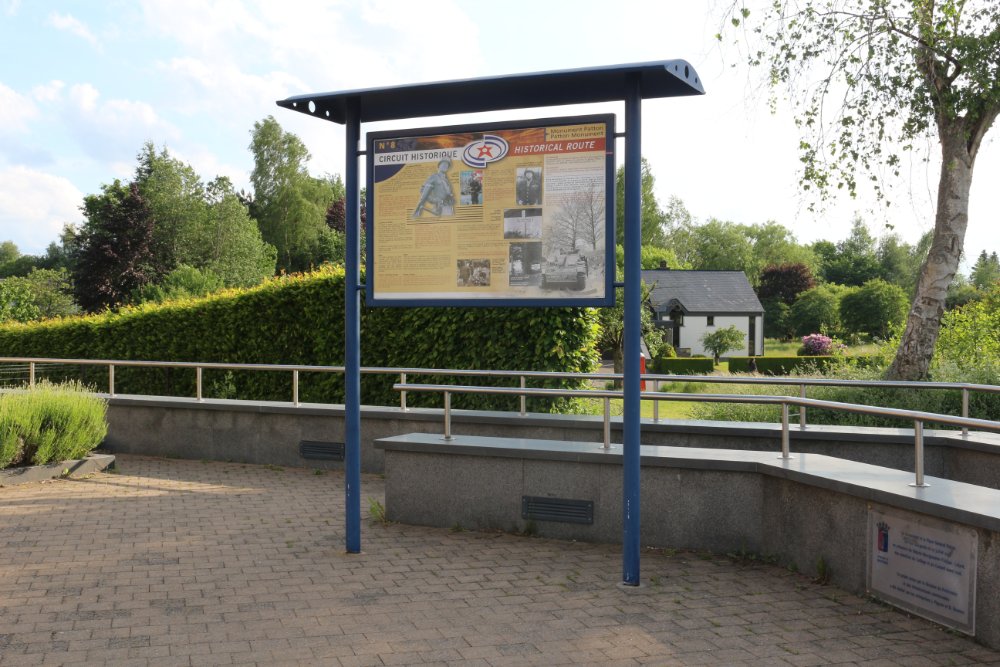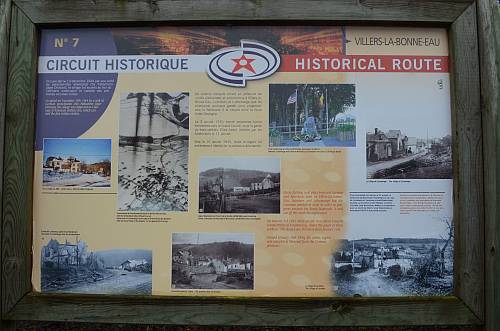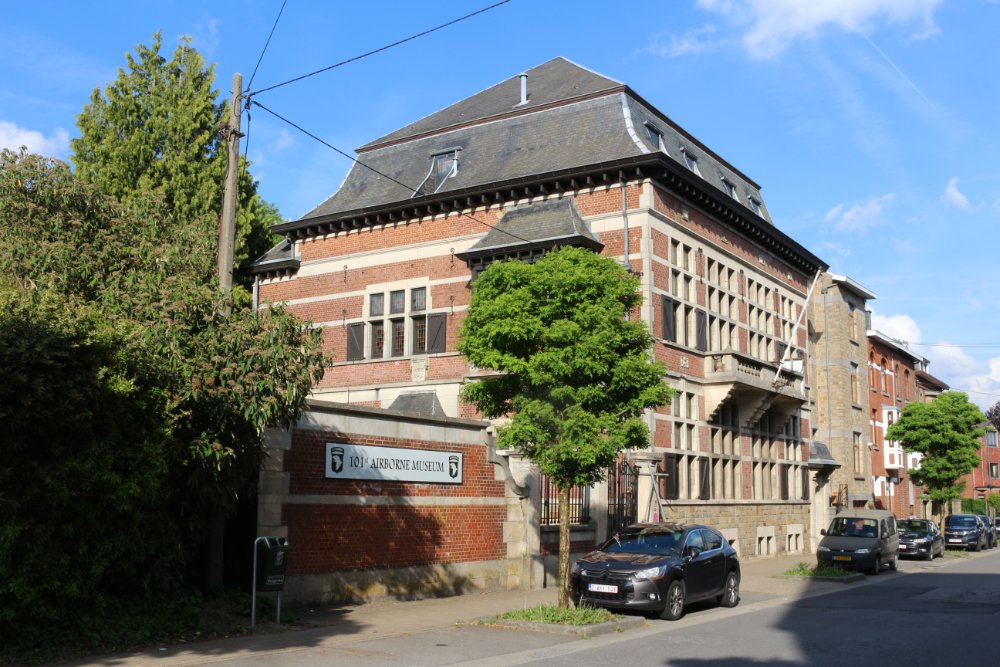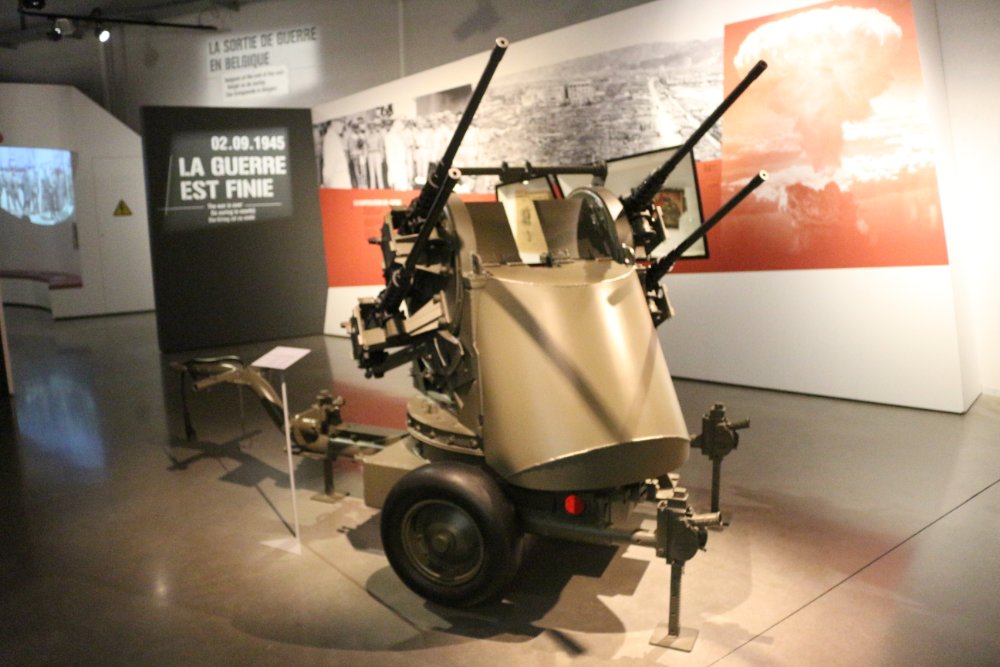Introduction
On the 16th of December 1944 the Germans launched a last offensive against the fast moving allied forces on the Western Front. No fewer than 24 German Divisions were involved in the attack. The purpose of the German offensive was to force a breakthrough in the Ardennes which would divide the allied troops in two and then to move towards Antwerp. The allies were completely surprised by the German attack and from 16 to 20 December the German troops advanced towards Stavelot, Sankt Vith, Houffalize and Bastogne. Bastogne was a crucial hub in the Ardennes for traffic, which controlled the north - south and east - west routes. Eisenhower realized the strategic value of the Bastogne cross roads and sent the 101st Airborne Division to the town. The city had to be held at all cost. On 20 December Bastogne had been surrounded by the Germans. They employed all possible efforts to conquer the town, which led to the Battle for Bastogne. The deceleration the German progress suffered from because of the Battle for Bastogne proved to be crucial for the further development of the offensive.
Definitielijst
- offensive
- Attack on a smaller or larger scale.
Images
Establishing the defenses
Eisenhower immediately estimated the attack in the Ardennes to be very serious. The Germans would not be allowed to reach Antwerp and separate the allied forces from each other. All reserves had to be sent to the Ardennes. But the only armored and infantry reserves of any substance Eisenhower could apply in Europe was the British XXX Corps. In September they had been the ground troops that formed the arrow head of Operation Market Garden. But XXX Corps alone Eisenhower estimated to be not sufficient to stop the German attack. The 87th Infantry Division and the 17th Airborne Division were called up, but still had to come over from England. It would therefore require valuable time before they could possibly participate in the battle. So Eisenhower applied airborne troops. The 101st and the 82nd Airborne Divisions would have to defend Bastogne. Bastogne was a city with high strategic value in the Ardennes. It was an important crossroads and ideal for troop movements. If the Germans would succeed to conquer and held Bastogne, they could simply move their troops and armored cars.
The town had be kept in the hands of the allies. The weather however was too bad to allow for an air dropping operation. That’s why the two divisions had be moved by truck. Each and every allied truck in Belgium was ordered to get over to the barracks where the divisions were housed. The men were carried towards their destination in open trucks. During the ride there was foggy, drizzling rain which cooled the men down to an incredible level. Also the trucks drove towards the Belgium border with their headlights switched on. In spite of the diminished power of the Luftwaffe, this remained a dangerous bet. If only one single aircraft would have noticed the column, a disaster would have ensued. But the trucks had to get to Bastogne in as little time as possible and that was only achieved significantly faster with headlights on.
During their advance, it was decided that the 82nd Airborne Division had to head north. The division was applied to the defenses of Sankt Vith amongst others. The task of the 101st Airborne Division was to defend Bastogne only. This without a commander, as General Maxwell Taylor was on leave. He was replaced by Brigadier-General Anthony McAuliffe. The Germans had to be held up until the 101st Airborne Division had arrived in Bastogne. The Americans established road blocks with battle groups that were camped around Bastogne, like Combat Command B of the 10th Armored Division. The commander of this battle group, Colonel William L. Roberts, had to delay the advancing Germans. Three German columns advanced towards Bastogne. Roberts composed three battle groups in order to stop them.
These three teams established road blocks north and north east of Bastogne. One team Team Desobry went to Noville, Team O’Hara went eastwards to Wardin and Team Cherry was in between, direction Longvilly. Each team was named after their commander and was approximately composed of a tank company, a company of armored infantry, some engineers, medics and reconnaissance troops. The three teams positioned themselves around Bastogne. On their way they encountered a flow of exhausted, muddy and demoralized American troops. They were fleeing for advancing Germans. Colonel Roberts was a World War One veteran and had witnessed the withdrawal near Château-Thierry and had obtained permission to deploy those fallen behind. He put all soldiers, who were still able to fight, together in a unit that was nicknamed Team SNAFU (Situation Normal All Fucked UP).
The 101st Airborne Division arrived in the Bastogne area during the afternoon of 18 December, 1944, and McAuliffe sent the 501st Parachute Infantry Regiment off as a reinforcement for Team Cherry. Towards the end of the afternoon they had to advance to the east in order to get in contact with the enemy. Team Cherry and the parachute regiment faced the Panzer Lehr Division of Generalleutnant Bayerlein. Bayerlein could have confronted Team Cherry a lot earlier if he had neglected misleading information from some Belgian civilians. Bayerlein however did follow the information of the Belgian civilians which made him loose a lot of time. On 19 December Bayerlein proceeded towards Bastogne. Near the village of Neffe a German tank hit a mine which further delayed the advance. Team Cherry and the para troopers regiment also approached Neffe. In Wardin a company of the 3rd battalion parachutists faced a battalion Pantzergrenadiere supported by seven tanks. In Bizory the 2nd battalion paras hit upon the reconnaissance battalion of the 26. Volksgrenadierdivision.
At Neffe a road block of the reconnaissance platoon of Cherry was overrun. Team Cherry therefore received a tough bashing from Panzer Lehr. McAuliffe sent a battalion of the 327th Glider Infantry Regiment. In spite of the heavy losses suffered, Team Cherry succeeded in blocking off a breakthrough into Bastogne.
Team Desobry had arrived just before midnight on 18 December in Noville. Desobry had defense positions established and placed roadblocks on the roads to Noville. In the early morning hours of 19 December Team Desobry engaged spearheads of the 21st Panzerdivision. These attacks were successfully defended and the Germans withdrew in the direction of Houffalize. Around 10:30 a tank battle started at Noville. Team Desobry had received reinforcements by means of a platoon of self-propelled guns of the 609th Tank Destroyer Battalion. The German 2. Panzerdivision lost seventeen tanks. Team Desobry lost one single tank destroyer and four smaller transports.
Desobry realized that his battle force ultimately would be too small to finally halt the Germans. He wanted to withdraw from Noville, but this was discommended by Colonel Roberts. Team Desobry received reinforcements of the 1st Battalion of the 506th Parachute Infantry Regiment. In the morning of 20 December however it transpired that the Germans had blocked the road to Bastogne and held Foy. McAuliffe ordered to abandon Noville. On the way back from Noville the Americans were attacked by the Germans. This cost many losses. Towards the evening the survivors arrived at Bastogne. The Germans proceeded to the river Meuse. Capturing of the city was left up to Panzer Lehr.
Definitielijst
- Destroyer
- Very light, fast and agile warship, intended to destroy large enemy ships by surprise attack and eliminating them by using torpedoes.
- infantry
- Foot soldiers of a given army.
- Luftwaffe
- German air force.
- mine
- An object filled with explosives, equipped with detonator which is activated by either remote control or by colliding with the targeted object. Mines are intended to destroy of damage vehicles, aircrafts or vessels, or to injure, kill or otherwise putting staff out of action. It is also possible to deny enemy access of a specific area by laying mines.
- Regiment
- Part of a division. A division divided into a number of regiments. In the army traditionally the name of the major organised unit of one type of weapon.
Images
The city surrounded
McAuliffe now disposed of the 101st Airborne Division, Combat Command B of the 10th Armored Division and the 705th Tank Destroyer Battalion of the 9th Army. He had his troops install a ring of defenses around the town with seven artillery battalions in the center of the ring. The Germans still tried a number of attacks at the furthest outposts of the defenses, but these attacks were successfully resisted thanks to the artillery. The Germans now advanced further, Bastogne threatened to become surrounded, but withdrawal was no longer an option as the troops would then be slaughtered to pieces. McAuliffe assured that the city would be held.
Shortly afterwards the Germans closed the ring around Bastogne. The city was surrounded now. The 21st and 22nd of December were relatively quiet days in Bastogne. The Germans prepared a large offensive with which they would be able to conquer Bastogne. The para troopers quietly waited until they would be relieved by advancing ground forces and in the meantime engaged in some smaller skirmishes with the Germans. There was a problem however on the side of the Americans. Their ammunition got exhausted. Because of their hasty departure the men carried only a limited supply of ammo with them when they arrived in Bastogne. Also the artillery threatened to run out of shells. The grenades they had left over had to be saved for an attack on the city. German troops could therefore advance along the town rather undisturbedly, which made the position of Bastogne more and more isolated. Medical supplies also got exhausted. The medics of the division were taken prisoner by the Germans on the 19th of December. The wounded only could be carried to field posts where exhausted surgeons and nurses could only try to apply help.
The German advance had already suffered from delays since the beginning of the offensive and some important areas had remained in the hands of the allies. When it transpired that the Germans would not be able to reach Antwerp, the capturing of Bastogne became a priority. That made quick movements of the troops possible and the roads through Bastogne were conveniently situated for the retreating Germans. The Germans engaged 15 divisions of which 4 armored divisions.
On the 22nd of December men of F-Company of the 327th Glider Infantry Regiment from their fox holes saw four Germans approaching with a white flag. Sergeant Oswald Y. Butler and Sergeant Carl E. Dickson left their command post which had been established in a farmhouse in order to investigate. They had with them Private Ernest D. Permetz as an interpreter. The Germans, two soldiers and two officers from the Operations Section of Panzer Lehr wanted to speak to the General in Charge. The soldiers had to stay behind and the officers were blindfolded and taken along and they handed Company Commander Captain James F. Adams a typewritten message both in German and English. It was an ultimatum from the German Commander in Chief.
There was only one possibility which could save the surrounded Americans from ‘total annihilation’ and that was an honorable capitulation. They had two hours to think about it. If it would be rejected the Germans would completely destroy Bastogne by means of artillery fire. That would involve many civilian victims and that ought not to match the humanitarian image of the Americans. When McAuliffe learned about the demand for a surrender he exclaimed: "Nuts!". But how could the Americans clarify that to the Germans? The men gathered around McAuliffe did agree that the first reaction was the very best. It seemed to the Americans to be a correct answer. So McAuliffe wrote back : "To the German Commander: Nuts! From the American Commander."
The Germans who had to carry the answer back with them, did not understand a syllable. The American Colonel Joseph Harper translated the message for the Germans. It meant to say: "Go to the devil!" The demand for capitulation was an initiative of General der Infanterie Von Lüttwitz. When General der Panzertruppen Von Manteuffel found out about the demand he was outraged. He did not have sufficient artillery capacity to back up the threat. Nevertheless he decided to make the Americans aware of what the German forces were capable of. Bastogne was going to be completely destroyed by an air raid.
On December 23rd the weather cleared. At 09:00 am teams of scouts were dropped in order to mark drop zones for the pilots of the C-47s (Dakotas). 214 aircraft dropped 144 tons of supplies for the troops in the surrounded city. Only a few of these tons landed behind enemy lines. During the following four days , only at Christmas day flying was impossible because of bad weather at the British airfields, 962 C-47s dropped 850 ton supplies. The different supplies could be distinguished by means of the color of their parachutes. Red for ammunition, yellow for equipment, blue for rations and white for medical supplies. On December 26th a number of gliders with surgeons landed. During the actions of the air bridge the Germans shot down19 aircraft and damaged some fifty others seriously. The fighter aircraft that escorted the freighters strafed the German troops outside Bastogne.
So the 101st Airborne Division was resupplied again and the division required these stocks. The clear and cold weather was also in the advantage of the Germans. The tanks no longer got stuck in the mud and snow but were able to drive along frozen tracks. Oberst Heinz Kokott was in command of the 26. Volksgrenadierdivision which was reinforced with tanks and Panzergrenadiere from Panzer Lehr. He rigged an attack in the south east, the area that was defended by the gliders’ infantry who were commanded by Colonel Harper, the one that had been so nice to translate McAuliffes’ answer. In the evening when it started to get dark the Germans attacked.
It seemed Kokott had forced a breakthrough in the direction of Bastogne as he conquered Marvie, but Team Cherry and a battalion of the 501st Parachute Infantry Regiment closed the gap in the American line. In the evening of 24 December, Christmas Eve, the German bombers appeared over Bastogne. Mostly Ju-88s, antiquated models, which illustrated the condition of the Luftwaffe. A heavy bombardment followed which destroyed large parts of the town. It had however not the result the Germans expected.
The Americans still held on and the civilians still kept to the side of the 101st Airborne Division. This was of great importance as the Americans benefitted much from the assistance the civilians offered them. A quote from Lieutenant-Colonel Harry Kinnard represents the value of the civilian support well: "A key factor for our success were the inhabitants of Bastogne. They wanted us to win, they did everything to support us. They showed us hidden supplies, they gave us white shirts and sheets so we could camouflage ourselves in the winter landscape. They provided nurses who worked in our lazarettos and supplied medicine." Earlier that evening the forces had received a Christmas message from Brigadier-General McAuliffe. In this message the men were briefed about the request for surrender and the answer to that: NUTS!
A big offensive was carried out on Bastogne on Christmas day. Kokott engaged a Panzergrenadierregiment, two battalions self-propelled artillery and 18 tanks for the battle. These were reinforced with a Volksgrenadierregiment and almost all artillery he had at his disposal. The Germans broke through the lines of the 327th Gliders Infantry Regiment and the 502nd Parachute Infantry Regiment, who were pushed back to the dense woods around Bastogne. From these woods the Americans laid such heavy barrage on the attackers that the Panzergrenadieregiment could not penetrate any further. Also some of the tanks were disabled by para troopers and tank destroyers. Eleven tanks conquered Hemroulle, after which a tank commander reported to Kokott that his tanks were in Bastogne. The German tanks had been halted in Hemroulle and destroyed by American tanks, tank destroyers , artillery and bazookas. On 26 December Kokott would again attack in order to break through to Bastogne, but this attack was nothing compared to the one of 25 December. This attack was therefore countered rather easily.
Definitielijst
- capitulation
- Agreement between fighting parties concerning the surrender of a country or an army.
- Destroyer
- Very light, fast and agile warship, intended to destroy large enemy ships by surprise attack and eliminating them by using torpedoes.
- Infantry
- Foot soldiers of a given army.
- Luftwaffe
- German air force.
- offensive
- Attack on a smaller or larger scale.
- raid
- Fast military raid in enemy territory
- Regiment
- Part of a division. A division divided into a number of regiments. In the army traditionally the name of the major organised unit of one type of weapon.
Images
The encirclement broken
On 19 December, 1944, a conference took place between Eisenhower and his army group commanders and army commanders in Verdun with reference to the situation in the Ardennes. Most commanders were seriously worried about the German advance, except for General George Patton. He said: "Hell, let's have the guts to let the bastards go all the way to Paris. Then, we'll really cut 'em off and chew 'em up." Of course the other commanders did not agree with this plan. Eisenhower wanted to know how much time Patton would need to turn his offensive from east to north and doing so, attack the German infringement, cut it off and liberate Bastogne. Patton said that he could achieve that in two days which caused quite a lot of commotion. But Patton was convinced that he could succeed in carrying out one of the most difficult operations of the war.
The turning of his army from heading east to north, a logistics nightmare, would be finalized on 22 December and then he would advance in the direction of Bastogne. In the evening of 22 December Patton’s troops had only covered eleven kilometers which was already quite a distance with a view to the rough weather. The next morning Patton wrote a poem to God in which he prayed for better weather. This text was distributed among the men and it appeared to be a true boost of their morale. The prayer of Patton seemed to be heard when in the afternoon of 23 December the weather suddenly cleared. Supplies were dropped over Bastogne and fighter aircraft attacked the German positions. The surrounded troops could hold out again a bit longer and the German defenses were weakened some more. In the evening the bad weather returned. In the next two days the German attacks became more and more fierce. The reason for that were the ever approaching troops of Patton.
The attack of the 26th of December would become the last offensive aimed at Bastogne by Kokott. The vanguard of Patton’s 3rd Army was only six kilometers away from Bastogne. Later that day the American 37th Tank Battalion under the command of Lieutenant-Colonel Creighton Abrams would break through the German lines and penetrate the encirclement of Bastogne in the south. The troops of Creighton had earlier that day been engaged in heavy fighting at the village of Assenois. After the conquest of the village they advanced further on to Bastogne. On their way to Bastogne they encountered an old Belgian strong house. Right at that moment military engineers of the 326th Airborne Engineer Battalion also wanted to attack this bunker. 1st Lieutenant Charles P. Boggess, who was in command of the tank column, shot the bunker to pieces with the gun of his Sherman and made contact with the engineers. After six days the men of the 101st Airborne Division and the troops that supported them had surface contact with allied forces. McAuliffe drove towards the point of the breakthrough in order to thank Creighton Abrams and to congratulate him. Patton had covered the distance from the Saarland to Bastogne in only five days. It concerned six American divisions of General Patton’s 3rd and 12th Corps. This involved all together 133,178 vehicles. These had have to proceed towards Bastogne across frozen roads and through the snow. That was a unique effort. Such a troop movement in such a short notice has never been equaled since.
The battle for Bastogne however had not yet been decided. Patton had reached the town though, but his narrow corridor between the German armored divisions was very vulnerable to attacks at its flanks. The Germans were determined to break through this corridor. Patton had counted with that and his troops were prepared for German attacks. Around the year’s change the fighting for the corridor had swallowed another six German divisions. The troops of Patton seemed to be too strong and the Germans launched a divertive attack on Devers in the Alsace, operation Nordwind. With this attack the Germans hoped to lure Patton away from the Ardennes in order to make sure his supply lines were not cut. Devers however could hold on without help from Patton, but it lasted till half way January before this attack was completely warded off. Patton’s corridor appeared impenetrable for the Germans. They had to abandon the conquest of Bastogne. The battle had been decided in favor of the allies.
The 101st Airborne Division earned a legendary fame in the battle for Bastogne. Already before the battle had been decided the American Ministry of War had published which division was involved in Bastogne. This normally never happened. The reason it was done this time is probably due to morale. Operation Market Garden a few months earlier had been a failure, which was a blow for their morale. Yet the cause for the failure of Market Garden was not dedicated to the capability of the German forces. And now the Germans appeared to be able to create a large offensive, morale was hurt again. The Chief of Staffs in Washington, George Marshall, prepared a memorandum after the German attack in the Ardennes about a subject that a few months earlier never even would have been discussed: that the allied forces might not be sufficiently strong to force Nazi-Germany on its knees. Marshall feared the allies might be required to negotiate a peace treaty. In order to keep up morale the only place where the Americans at the start of the Ardennes offensive could stop the Germans permanently, near Bastogne, was blown up in proportions. The men were also called "the Battered Bastards of the Bastion of Bastogne". The occupation of Bastogne therefore held next to a strategic value also large value for the morale of the allied forces.
Definitielijst
- Ardennes offensive
- Battle of the Bulge, “Von Rundstedt offensive“ or “die Wacht am Rhein“. Final large German offensive in the west from December 1944 through January 1945.
- Nazi
- Abbreviation of a national socialist.
- offensive
- Attack on a smaller or larger scale.
Images
Information
- Article by:
- Pieter Schlebaum
- Translated by:
- Fred Bolle
- Published on:
- 19-04-2014
- Last edit on:
- 30-09-2024
- Feedback?
- Send it!
Related sights
Related books
Sources
- AMBROSE, S., Van D-day tot Berlijn, Mynx, 2008.
- ANDERSON, D., Het einde van het Derde Rijk, Zuidnederlandse Uitgeverij N.V., Aartselaar.
- CROSS, R, De slag om de Ardennen, Zuidnederlandse Uitgeverij N.V., Aartselaar.
- HEIJ, G., De bevrijding, Uitgeverij Terraannoo B.V., Arnhem, 2010.
- KNOPP, G, De bevrijding, Uitgeverij Verba, Hoevelaken, 2005.

